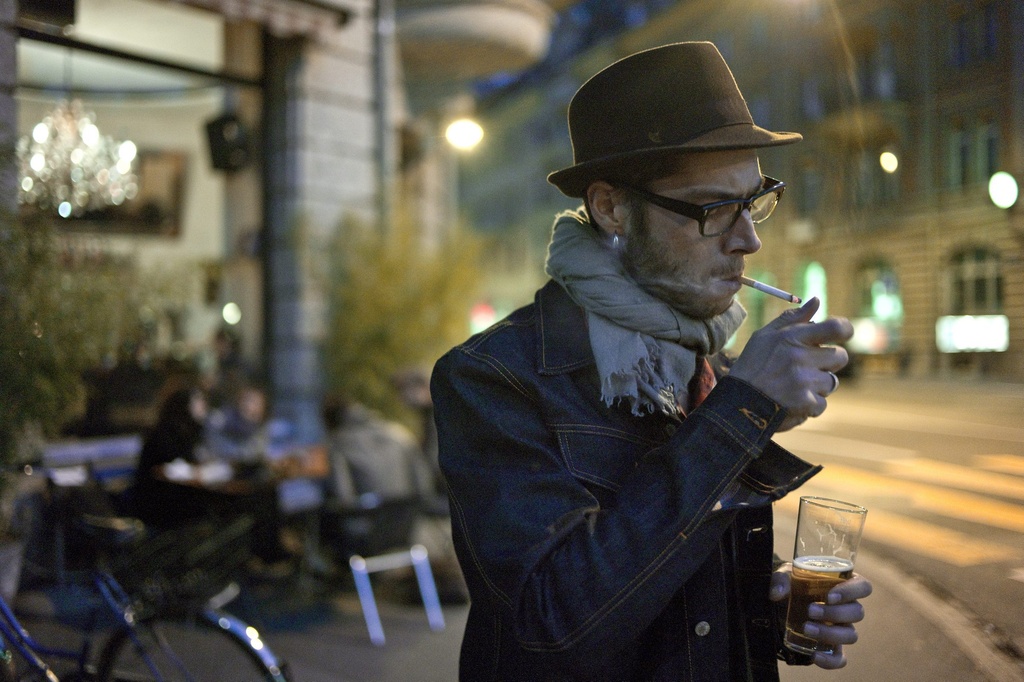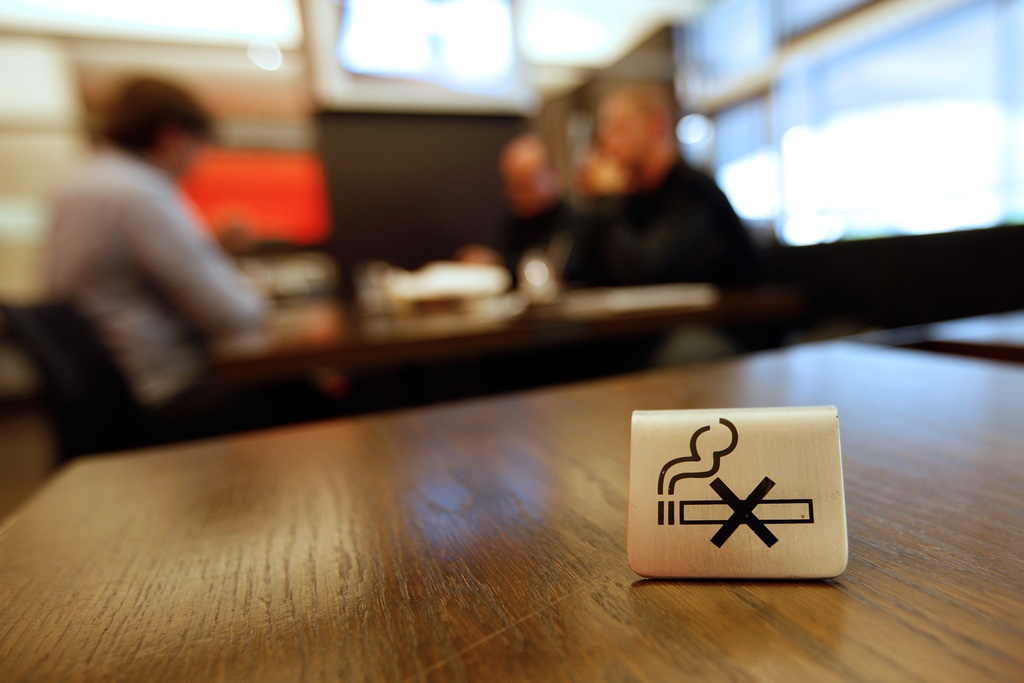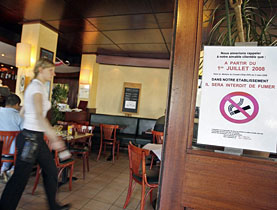Swiss stub out their cigarettes – almost

A nationwide law aimed at stamping out passive smoking in public spaces in Switzerland came into force on Saturday.
The legislation gives cantons, which have differing approaches to the issue, minimum standards to apply. But some say that it does not go far enough.
Nicole Disler of the Federal Health Office told swissinfo.ch that second-hand smoke was a serious health risk and that the new law would provide protection to non-smokers.
“There is no lower limit where second-hand smoke would not be harmful, and it can cause among other things, lung cancer, cardiovascular diseases, asthma and infections of the respiratory system,” she said in an email.
Some countries, including Swiss neighbours Italy and France, already have a nationwide ban in place. But Switzerland’s federal system, which had left the cantons in charge of the issue, resulted in a more piecemeal approach.
The Italian-speaking southern canton of Ticino was the first to ban smoking three years ago. Other cantons followed suit, with some allowing staffed smoking areas and others permitting small “fumoirs” without service. Some, such as Appenzell Inner Rhodes, did not implement any measures.
Minimum standards
From May 1 smoking will no longer be allowed in public spaces, including bars and restaurants, schools, hospitals and shopping malls, across the country.
But there are exceptions. Catering outlets can set up staffed smoking rooms with ventilation and small locales of up to 80 square metres may remain open for smokers.
“The new law is providing a minimum regulation for the whole country,” Disler said.
Cantons are free to decree additional regulations and those that already have stricter measures can keep them in place.
However, some argue that Switzerland should have one rule for everyone.
People’s initiative
The Swiss Lung League has already gathered 120,000 signatures in favour of a people’s initiative to ban smoking in all indoor public spaces. It also wants to outlaw staffed fumoirs.
Looking at cantonal vote results, the initiative appears to have a good chance. Almost 80 per cent voted in favour of a smoking ban in Ticino when the issue came to the polls in 2006. Last year more than 80 per cent in canton Geneva signalled their approval.
But there is also some opposition. A group of restaurateurs has launched an initiative to allow establishment owners free choice over smoking. But it does not have the support of the umbrella group of the catering industry, Gastrosuisse.
For Angelo Tomada, scientific collaborator at the Health Promotion and Assessment Office in canton Ticino, there is another problem with the law.
“It is not at all satisfactory because it does not make the aim of the smoking ban completely concrete, namely to protect staff,” he said.
Ticino’s experience
Ticino has seen positive effects since its ban was enforced, Tomada said.
A survey found that before the ban 15 per cent of employees often complained of headaches and 12.9 per cent said they had to cough frequently. A year later this had fallen to 10.5 per cent and 7.6 per cent respectively.
“It also found that the smoking ban was generally well accepted by customers, employees and owners,” said Tomada.
One of the main arguments against the ban is that it could affect turnover, which was a consideration in the federal law’s exemption clause for small locales.
In Ticino one in five establishments, especially the small and medium-sized ones, has reported lower revenue. But some had already seen a drop before the ban, Tomada pointed out.
Economic impact?
In fact, it is hard to tell how much of an economic impact outlawing smoking has had, especially since there are other factors, such as the economic downturn, he added.
“There have probably been small problems,” Tomada said, adding that landlords who were against the ban tended to give more negative answers than those in favour. Research in other countries has concluded that there was no great economic impact.
But what about smoking habits? “A secondary aspect of the law could be to try to reduce the number of smokers. This has not happened and furthermore research has shown that there are only at most small changes in the short term,” said the expert.
The move has to be considered in a wider context of prevention measures and in the mid-term.
“Overall in the last decade we have in fact seen the number of smokers drop from 32 per cent to 27 per cent,” Tomada said.
Daniele Mariani and Isobel Leybold-Johnson, swissinfo.ch
Each day 21% of the Swiss population is exposed to passive smoke for at least an hour, according to a passive smoking report by Zurich University in 2008.
83% of people in bars and restaurants, the principle areas for exposure, said they were bothered by second-hand smoke.
The percentage of staff exposed at the workplace dropped from 54% in 2001-2002 to 35% in 2008.
66% of the population aged 14-65 would like a general ban on lighting up in bars and catering establishments. People are more in favour in the French-speaking part (76%) than in the German-speaking part (64%). Ticino and Graubünden, which had already introduced a ban at the time of the survey, had higher numbers, around 83%.
Three quarters of European countries have introduced restrictions or bans on smoking.
Countries where smoking is totally banned in bars and restaurants: Albania, Croatia, Estonia, Finland, France, Britain, Ireland, Iceland, Italy, Latvia, Lithuania, Macedonia, Malta, Norway, the Netherlands, Slovenia and Sweden.
Bans with restrictions: Germany, Austria, Belgium, Denmark, Spain, Liechtenstein, Luxembourg, Montenegro, Portugal, Czech Republic and Romania.
No restriction plans: Bosnia-Herzegovina, Bulgaria, Cyprus, Greece, Hungary, Poland, Serbia and Slovakia.

In compliance with the JTI standards
More: SWI swissinfo.ch certified by the Journalism Trust Initiative














You can find an overview of ongoing debates with our journalists here . Please join us!
If you want to start a conversation about a topic raised in this article or want to report factual errors, email us at english@swissinfo.ch.